Comparing New Balance vs ASICS running shoes is another breakdown of proprietary technologies, fit, and feel. Both brands are well loved and used because they make high quality running shoes for various running styles and foot types. So we’ll dig in to the different models to help you find the best shoe for your workouts.

Both brands are known for their quality and offer a variety of models to suit different needs like overpronation, low arches, cushioning, and various styles of running.
I do admit to having a deep love for New Balance as I helped to create their first ever online Wear Test program back in my consulting days!
The Main Differences New Balance vs ASICS
New Balance and ASICS offer similar features and models for all kinds of runners, from the casual runner to extreme marathoner to the flat-footed or high-arched.
I break down the differences in more detail below, but here’s a quick overview:
New Balance Running Shoes
- Offers wider shoes than most brands
- Thicker midsole provides more stability
- Makes more shoes in the US than any other brand
- Also big in the athleisure market
ASICS Running Shoes
- More narrow fit, especially in the heel and midsole
- Famous for its GEL technology, which provides shock absorption
- Designs a variety of shoes for many different sports
I’ve worn both brands and will add some personal thoughts, along with links to detailed reviews.
New Balance vs ASICS Feature Comparison
Both brands have been around for a very long time and are leaders in running shoe design. They both offer various technologies to aid with comfort, support, stability, and cushion.
Where they differ most is in the fit.
The following breaks down each shoe based on the components buyers need to consider when purchasing a running shoe.
It’s gonna get a little TECHY…so you can just skip on down to the specific model comparison if you want, but personally if I’m shelling out $150 for shoes, I kinda want to know why.
Durability
The lifespan of shoes from both companies is fairly comparable.
- New Balance shoes have a life expectancy ranging from 300 to 500 miles, or three to six months, depending on your monthly mileage.
- ASICS recommends swapping out for new shoes every 450 to 500 miles.
Determining when to replace running shoes, of course, all depends on your gait, weight, and whether you run mostly on trail or road.
Breathability
New Balance uses what is called a Hypoknit upper which offers the moisture wicking and breathability you want in your long run shoe.
ASICS Ortholite Lasting material provides a plush underfoot cushion while managing moisture build up from sweat, allowing for maximum breathability.
Across MOST running shoes, the only time you now won’t find them to be breathable is if you get to Gore-Tex shoes that are designed to be water repellent or water resistant.
Fit
New Balance is one of the few running shoes that offer wide widths and go up to a lot more sizes. This is one reason they are so popular among workers.
Note, they also offer 2A which is extra narrow. And like most brands, they have a shoe finder to help you decide what might be the best fit.
Additionally, their shoe numbering system actually means something!! The last 2 digits tell you about the type of shoe.
40 (Optimal Control):
Shoes in this category provide superior control, stability, cushioning and support for biomechanical needs, such as pronation or low arches (e.g., 940, 1540).
50 (Fitness Running):
For training on roads or for indoor workouts, the 50 series offers the combination of visual attitude and innovation with the responsiveness and power athletes need.
60 (Stability):
Designs that offer industry-leading stability to reduce pronation while also providing unparalleled cushioning and comfort (e.g., 860).
70 (Light Stability):
The perfect combination of stability and speed, all in a lighter, sleek profile designed for runners who train at a faster pace (e.g., 770).
80 (Neutral):
For high-mileage runners who require light shoes and the protection of superior cushioning (e.g., 1080).
90 (Speed):
For faster runners who want every advantage, including a superior ride and fit. The choice styles for professional and nonprofessional speed and distance runners (e.g., 890).
ASICS shoes have a more snug fit, particularly in the heel and midfoot. An external heel clutch delivers targeted fit and support, while the Gel technology allows for foot movement in various directions as the foot transitions, reducing heel strike.
While ASICS also features a shoe fit guide, it takes a little sleuthing to find (you’re welcome).
 This is an older, yet still very USEFUL graphic from the Huffington Post.
This is an older, yet still very USEFUL graphic from the Huffington Post.
I forget we may not all know the lingo when talking about different components of the shoe and why they matter.
Cushioning
New Balance utilizes Fresh Foam and FuelCell foam depending upon the shoe. Both are designed to provide a lot of cushion without the weight. FuelCell is a nitrogen infused foam which provides additional softness and responsiveness.
ASICS uses Flytefoam technology that provides bounceback and responsiveness with each step. It gives a bit less energy return than Brooks shoes, but the two technologies are fairly similar.
The company has been using their famous Gel technology for more than 30 years. It works well to absorb the shock with each step.
Stability
New Balance utilizes a couple of tools to provide stability. The first is that similar to HOKA all of their shoes have a bigger platform, which naturally means more stability.
Then they have an S Curve to help with that side to side stability and a Ultra Heel that flares away from the ankle for comfort, while keeping your heel firmly in the shoe.
ASICS shoes provide stability through a dual density midsole system called Duomax, which enhances support and stability. That, along with the external heel clutch allow the foot to continue its natural movement while running.
Affordability
The prices between the two brands are fairly comparable. New Balance prices range between $80 to $130, while ASICS start at a slightly higher price at $110 to $160.
The most popular models for both brands are priced toward the higher range. Carbon fiber shoes and often trail shoes will go beyond those rates.
You’ll notice that every brand offers a range and this is indeed due to a difference in technology and where they sell the shoe. They know that the big box store can sell the shoe with less in it, while the local running store needs to be best for dedicated runners.
ASICS Vs New Balance Running Shoe Models
Now that you know more about each brand, let’s look at their top models in each of the main categories. There’s no winner declared here because all are great shoes, it’s just about which one is best for your foot.
Did you notice I even said the brands in reverse order this time…seriously no favorites, I have run in both brands many different times over the years.
Stability Running Shoe
👉ASICS GEL Kayano
The GEL Kayano is now in its 32nd iteration and known as one of the best stability shoes on the market. Great for overpronators seeking stability, the GEL Kayano is an ideal shoe for marathons.
It’s more cushioned than most stability shoes and thus has remained a favorite of many runners for a very long time. To be clear, it’s not that plush max cushion feel, but a moderate underfoot feel that allows for pronation correction.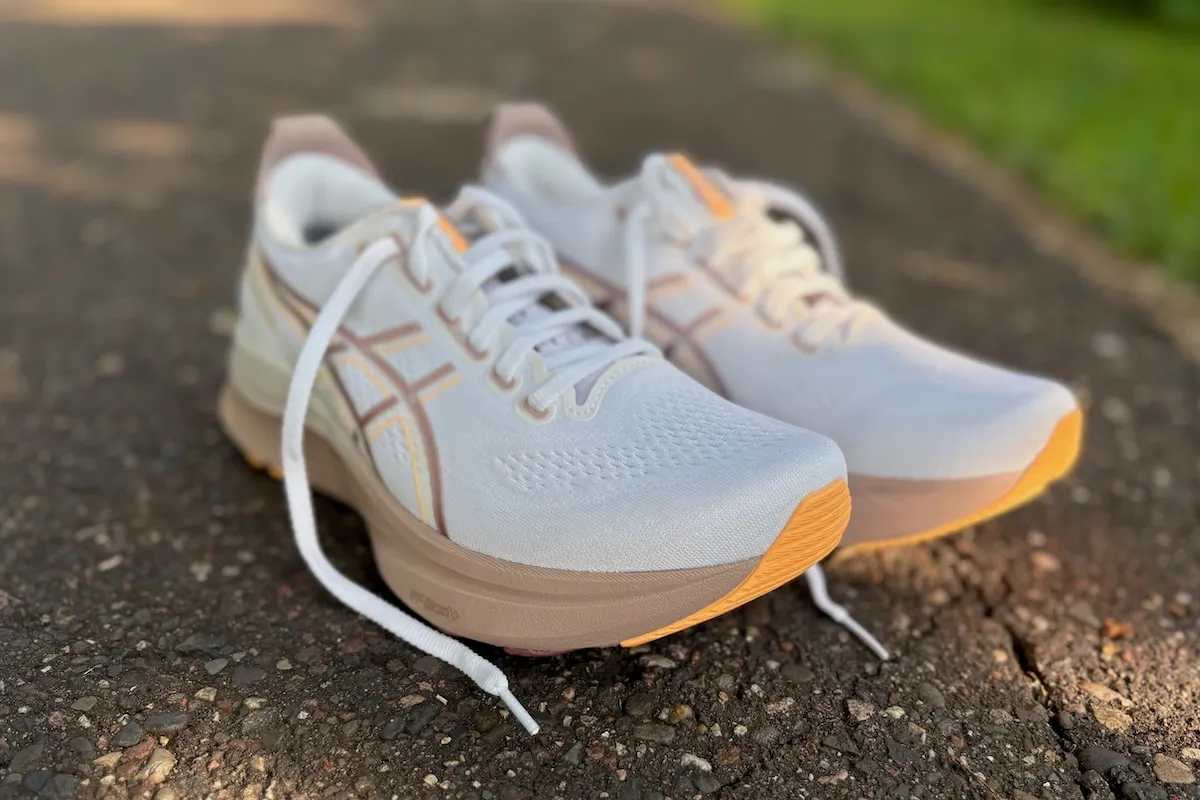
The fit is in line with most shoes, but you will notice a bit more of a heel lock. This is again to help with that foot pronation without over correcting.
- Weight: 10.7 oz Men’s, 9.1 oz Women’s
- Stack Height: 40 mm
- Heel Drop: 8 mm
- Available in nine colors
- Available in wide and narrow
- Available at Asics.com for $165.00
- Read our full review of the Asics Gel-Kayano 32 here >>
👉Fresh Foam 860 V 14
The New Balance Fresh Foam 860 v14 has a dual-density medial post in the midsole that helps with overpronation, which will stabilize your foot strike and help to keep you in better alignment.
A combination of hard and soft rubbers on the outsole of the Fresh Foam 860 imparts grip, while the firm midsole is useful at runs of a higher pace.
Wide is also available and that might be necessary for some of you to get just a little more room in the toe box.
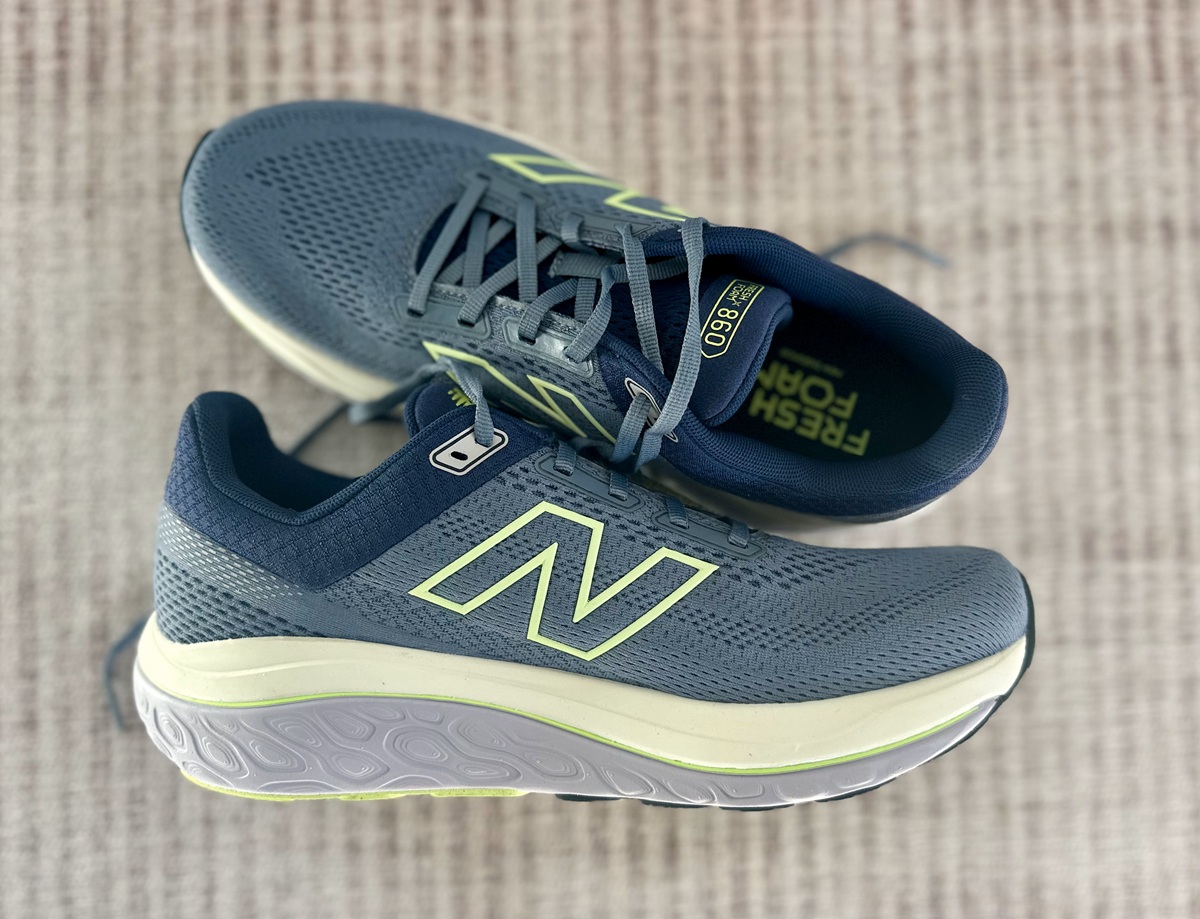
The breathable mesh upper keeps your feet cool and secure, and the cushioning is second to none.
It’s a stability running shoe that’s surprisingly light. It has a stretchy, spacious forefoot and toe box which is perfect if you have bunions!
- Weight: 10.8 oz Men’s, 8.7 oz Women’s
- Heel Drop: 8 mm
- Available in core and seasonal colors
- Available in narrow, wide and extra wide (in limited colors)
- Available on Newbalance.com for $140
- Check out our full review of the New Balance 860v14 here >>
Neutral Running Shoe
👉Asics Novablast 5
The Novablast has been a winning max cushion shoe from Asics since it first launched and they have continued to increase the amount of cushion in the shoe, while working to drop the weight. It’s not going to be the plush shoe you’ll see below, but it’s a great amount of cushion in a weight that’s going to translate to a lot of miles for the average runner from training even to race day.
The 5 has a completely new full length midsole with their FF Blast Max foam. Again, I like that this shoe is a more responsive cushion and you don’t sink in to it so much.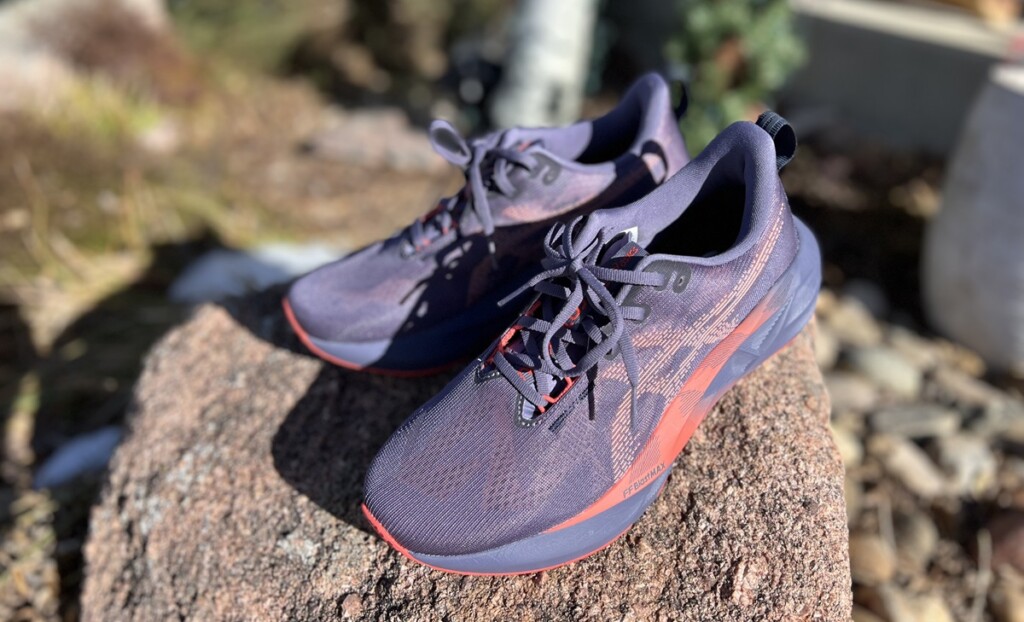
While this is a neutral shoe, with no guiderails or anything for stability, it absolutely has some of that built in to the design. The width of the platform from toe to heel reduces pronation and provides a really good ride.
- Weight: 7.9 oz women’s, 9.1 oz men’s
- Heel toe drop: 8mm
- 8 colors available
- Not available in wide
- Available at RunningWarehouse.com and Asics.com for $160
- Read my full review of the Asics Novablast 5 here>>
👉Fresh Foam 880 v 15
While some runners are flocking to carbon plated shoes, we simply don’t want those as our every day trainers. We want something that is solid and dependable like this neutral shoe that also has a great wide toebox, allowing you to get full power out of those feet.
It’s going to have enough cushion for long runs without being overly plush and still providing just a hint of stability with the bigger platform. I can concur from my running in fresh foam that you absolutely notice the cushion, but it’s still a solid shoe. You’ll see my absolute favorite NB shoe up next.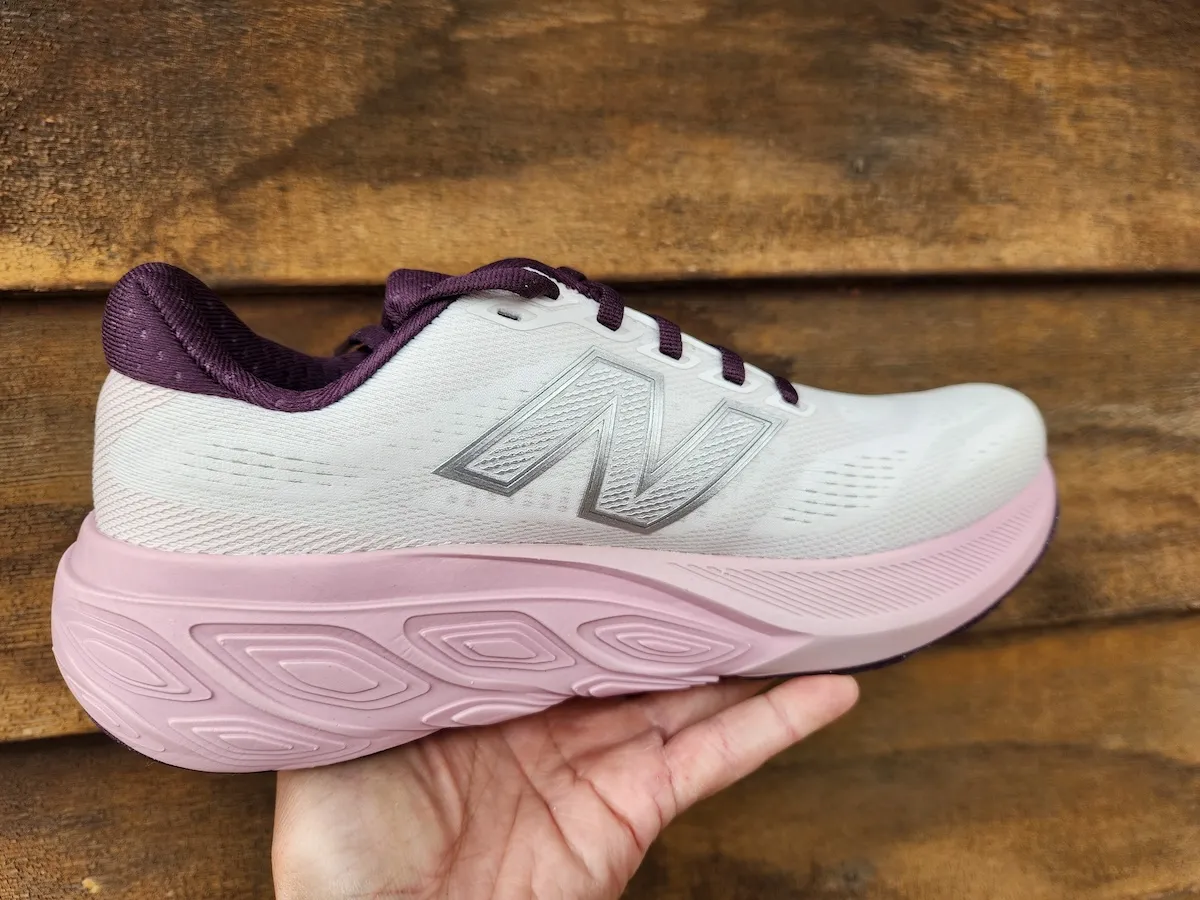
The upper part of the shoe is made of engineered mesh that ensures proper breathability and comfort. This shoe is suitable for runners who require moderate support and cushioning for their runs.
- Weight: 7.8 oz women’s, 9.6 oz men’s
- Heel Drop: 8mm
- Available in 10 colors
- Available in narrow, wide, and extra wide for specific colors
- Available on Newbalance.com for $140
- Read our full review of the NB 880v15
File this under your great every day trainer.
Cushioned Running Shoe
👉ASICS GEL Nimbus
This shoe will appeal to most runners looking for a neutral fit and some MAX Cushion.
This is the plushest shoe in their line up with a great big old stack height and we’re here for it. The most recent model feels like a great update to a shoe that will carry a lot of runners over long miles with foam that’s durable and a fit that isn’t overly soft.
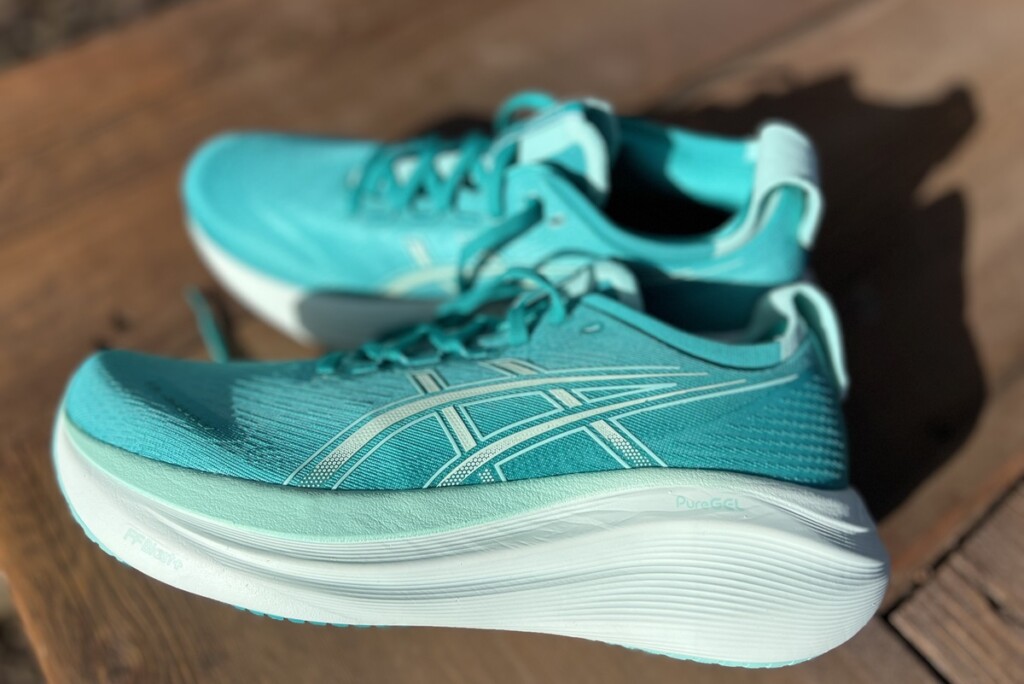 With the 42mm stack height, they did manage to retain a feeling of stability. The firmness that I wasn’t a huge fan of with the last one (because why should a max shoe feel firm) is gone and now it’s just a big cushioned ride. For me personally, I can’t say it’s a shoe I’d wear for anything other than easy runs. I certainly wouldn’t turn to it for tempo work or a race where a PR is the goal.
With the 42mm stack height, they did manage to retain a feeling of stability. The firmness that I wasn’t a huge fan of with the last one (because why should a max shoe feel firm) is gone and now it’s just a big cushioned ride. For me personally, I can’t say it’s a shoe I’d wear for anything other than easy runs. I certainly wouldn’t turn to it for tempo work or a race where a PR is the goal.
- Weight: 10.7 oz Mens, 9.2 oz Women’s
- Heel Drop: 8mm
- 4 colors available
- Not available in wide
- Available at Asics.com for $160
- See our full Asics Gel Nimbus 27 review >>
👉Fresh Foam 1080 V14
Listen, I like a good cushioned shoe and this one fits the bill. It’s become one of my go to long run shoes.
I’ve actually gone through 5 pairs of this shoe in the last few years in various models. The rave reviews make complete sense to me as someone who likes a good max cushioned shoe on long run days. The 14 definitely feels a little softer than some previous models, so you aren’t getting that energy return, but lots of cushion.
The base of the shoe is just slightly more flared or wider now, which also adds some stability. That’s a key feature that was lacking when many started shoving more foam into the midsole.
One notable change from last year, the shoe gained up 1 oz of weight. Which seems a little odd when the stack height remained the same, but seems to be related to adding some additional grip along the outsole which does make the shoe better in wet conditions.
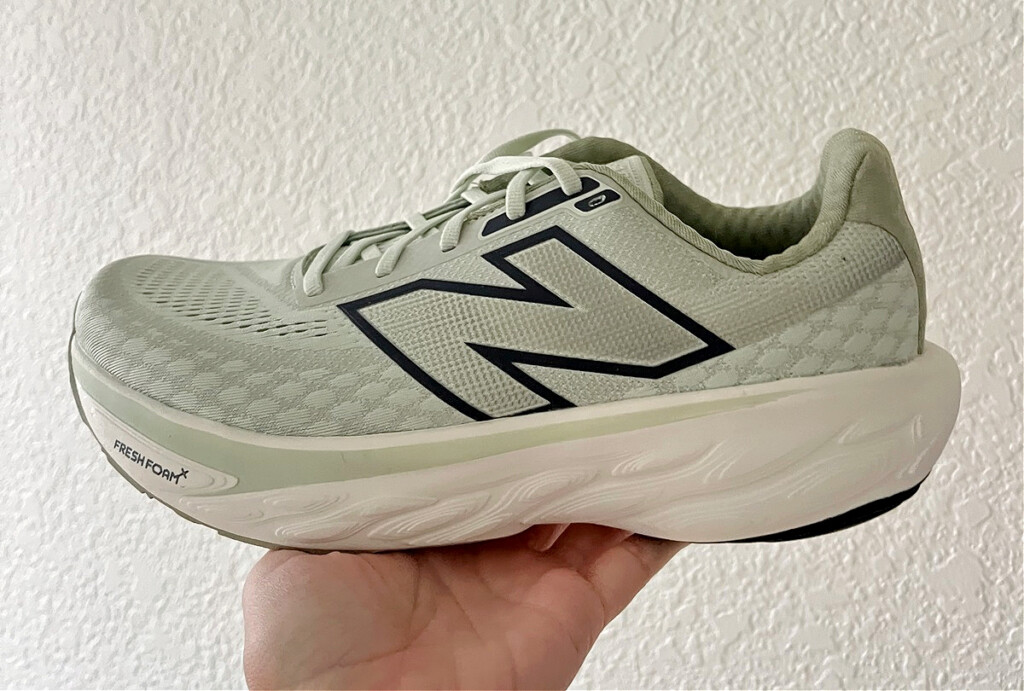
- Weight: 10.5oz Men’s, 8.3 oz Women’s
- Heel Drop: 6mm
- 8 colors
- Available in wide and extra wide
- Available on NewBalance.com for $165
- Read our full review of the New Balance 1080 v14 >>
Trail Running Shoes
While neither brand might be your go to for big ultra adventures or rugged terrain, they both offer some good options. These two are going to be great for those on less technical trails.
👉ASICS Gel Trabuco 13
We’ll be super honest and say that Asics hasn’t traditionally been a go to for us when it comes to trail running. But that doesn’t mean they aren’t in the space and figuring something out with the cushion that we already love.
If you’re looking to pick up the pace on the trails, this is going to be a great option. Asics used it’s FF BLAST PLUS ECO cushioning in the midsole to help absorb impact underfoot.
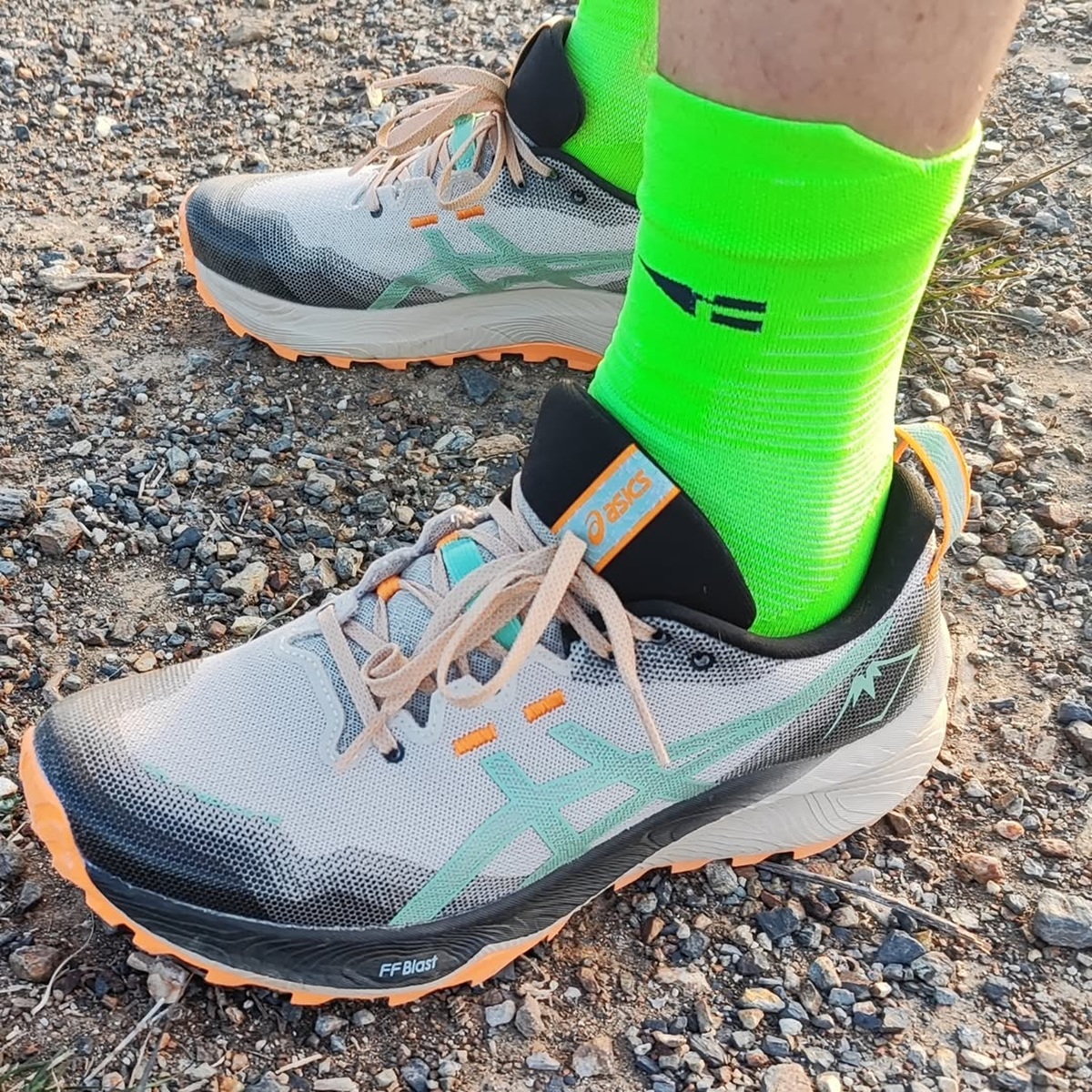
There’s also a rock protection plate at the front of the shoe to help protect your toes if you kick a rock or two while running!
The outsole is designed with the ASICSGRIP rubber to keep you steady on uneven ground and slippery conditions, which is perfect for slippery, more technical trails!
- Weight: 8.8 oz Women’s, 10 oz Men’s
- Heel toe drop: 8 mm
- 4 colors
- Not available in wide
- Available at Asics.com for $140
👉New Balance Fresh Foam Hiero
This shoe has gotten a lot of love over the years from runners. I think that’s because it could fall in to the road to trail category. You’re getting all that fresh foam and feeling that you love of a road shoe, but with some extra on the outsole!
These have what they called micro traction lugs. They’re going to work on most trails and give you even a good winter option, but probably not for the more rugged terrain or slippy trails where we want some big lugs.
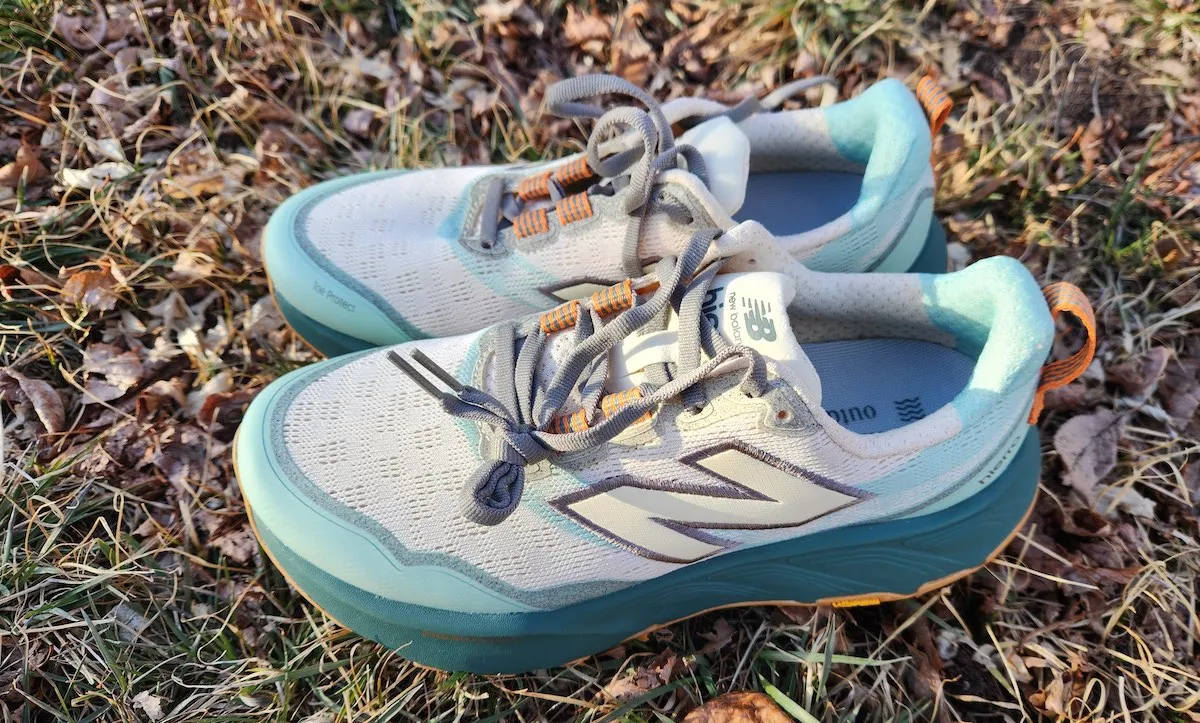
The New Balance Hierro v9 will provide a stable yet comfortable run for easy trail days with nice protection underfoot.
- Weight: 10.3 oz Men’s, 8.3 oz Women’s
- Stack Height (heel/forefoot): 42mm / 38mm
- Heel drop: 4mm
- Available in 3 colors
- Available in wide and x-wide
- Available on Newbalance.com for $155
- Check out our full review of the New Balance Hierro here >>
Carbon Fiber Plate Shoes
Are they cool new technology, yes. Do they last as long as your other shoes, nope.
So if you want to test these out use them for speed work and then race day!
👉New Balance FuelCell Super Comp Elite v4
The SuperComp Elite is New Balance’s high-performance carbon-plated racing shoe, designed for long-distance runners seeking a combination of speed, responsiveness, and cushioning.
The shoe boasts an eye-catching color scheme and distinctive geometric design, as well as easy rocker shape. And the midsole is THICK, made of peba foam (more on that in a bit), layered around a thin carbon fiber plate.
Our gear tester, Jeff, took these for a spin in the NYC marathon and said they’ll be a great option for the 4 hour marathoner!
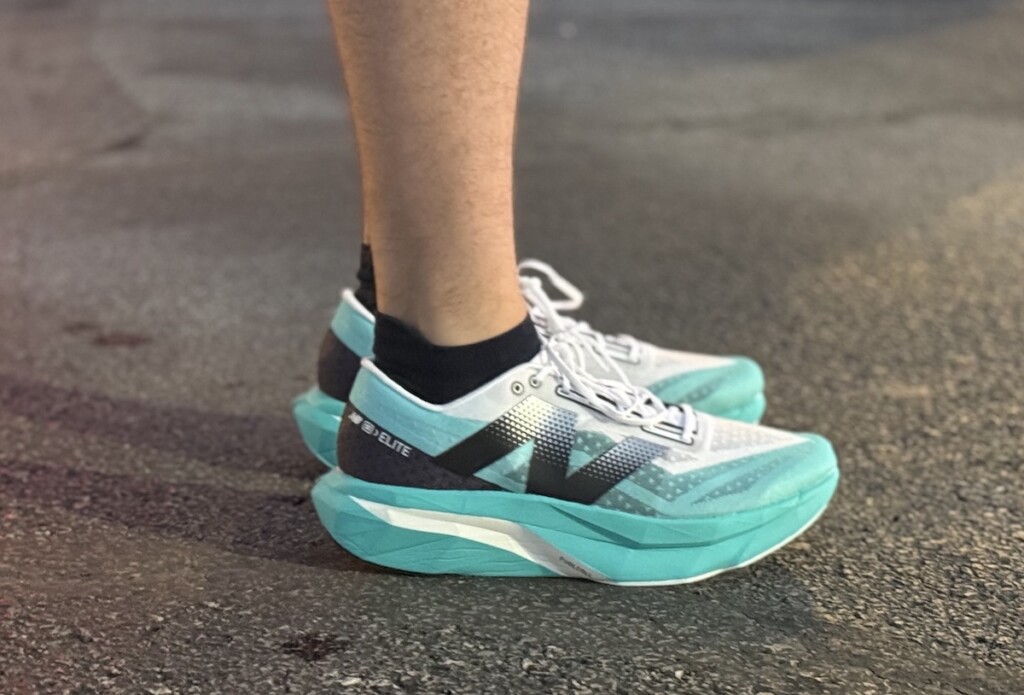
- Weight: 8.1 oz Men’s, 7.2 oz Women’s
- Heel drop: 4 mm
- 1 color available
- Available in wide
- Available at newbalance.com for $250
- Check out our full review of the FuelCell Supercomp Elite v4 here>>
👉ASICS Metaspeed Sky and Edge
ASICS is trying to catch up in this area and released a few shoes all at once which many folks can’t quit tell apart. The Edge is going to be the shoe with less cushion, less weight and better for those racing sub 3, etc.
This is a maximum cushioned carbon fiber plate for the marathon runner in you. It’s going to give you both that feeling of comfort over the miles along with the pop that’s often lost in a highly cushioned shoe.
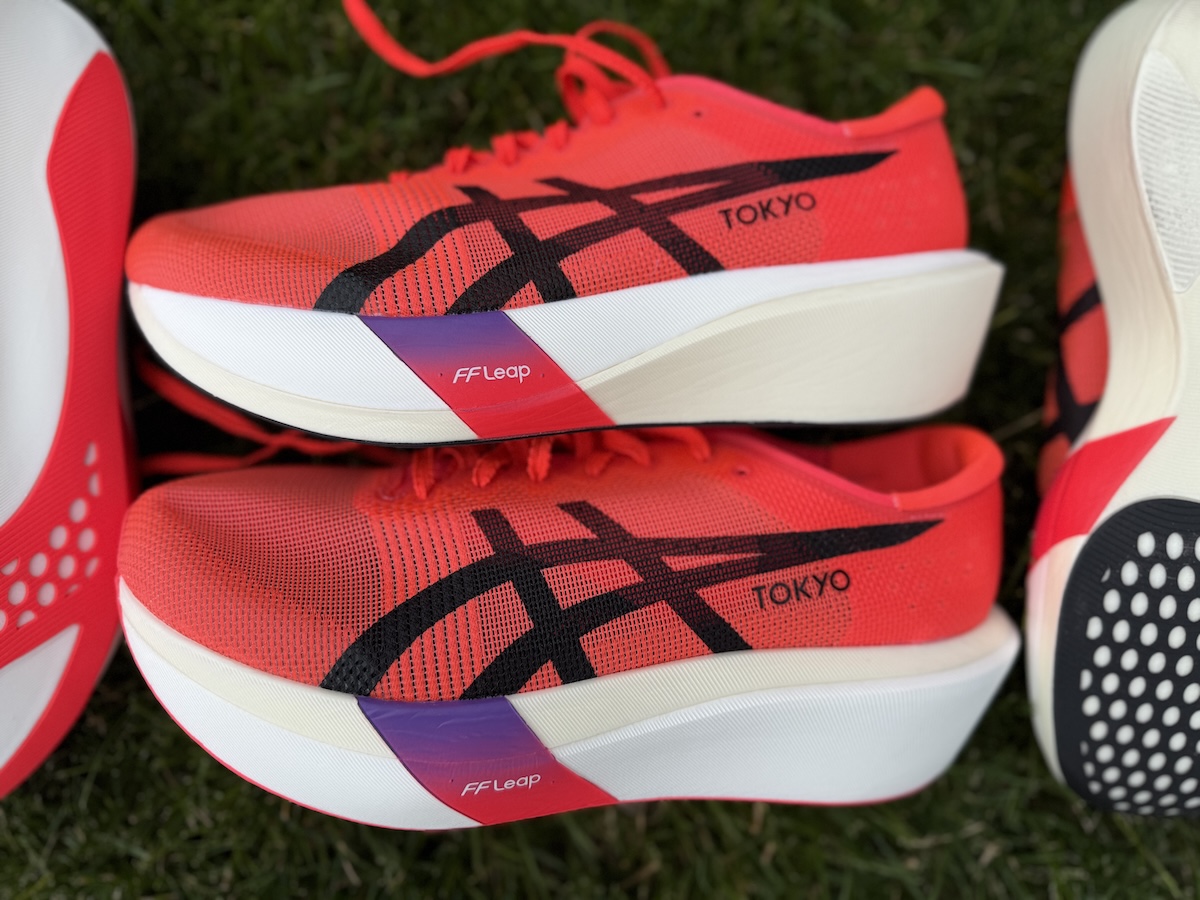 We did find that like many carbon plated shoes it doesn’t feel super stable, so if you have any ankle issues or need that wider base probably not a good fit. It’s also most ideal for the front of the pack forefoot to midfoot strikers.
We did find that like many carbon plated shoes it doesn’t feel super stable, so if you have any ankle issues or need that wider base probably not a good fit. It’s also most ideal for the front of the pack forefoot to midfoot strikers.
It’s not a back of the pack speed shoe, you won’t get the benefits because your gait is different.
A go-to pick for speed workouts and marathon efforts
- Weight: 5.8 oz Unisex sizing
- Heel drop: 5 mm
- 4 colors available
- Not available in wide
- Available from Asics.com $250
- Checkout our review to understand the Asics Metaspeed Sky vs Edge
Watch my detailed video on how Carbon Fiber Shoes work.
More About New Balance
New Balance actually started in 1906 as an arch support company! But their focus on feet is one of the reasons they do offer more sizes and widths than most other brands.
And that’s exactly what the Boston based company focused on until 1960. Athletes had begun using the arch supports and they decided it was time to venture in to sneakers.
The Trackster was the first shoe with a rippled outsole that provide additional traction. It caught on as a track and cross country shoe regionally.
But in 1976 the company released it’s first shoe with the well known N logo on the side and it was a success. They stuck to their goal of providing shoes for a variety of feet and took advantage of the 80’s running boom.
More About ASICS
Founded in 1949, by Kihachiro Onitsuka in Japan, ASICS is an acronym for the Latin expression “Anima Sana in Corpore Sano” (“healthy mind in a healthy body”).
The company released a basketball shoe in 1950, followed by running shoes in 1953. Among those running shoe products included the Onitsuka Tiger, still a popular shoe today, though mainly used as a casual shoe as opposed to a marathon shoe.
Today, Asics designs a wide variety of shoes including: running, tennis, volleyball, wrestling, and golf.
Fun fact: Nike was founded to sell the Onitsuka Tiger shoes in the US. After visiting Japan in 1963, Phil Knight was impressed by the high quality and reasonable prices and asked the company to represent the brand in the US. Anyone else read his book and find all of this fascinating?!
How to Choose ASICS or New Balance?
ASICS and New Balance are two extremely well known running shoe brands, but more important than brand is the fit of the shoe.
Your gait and feet will change over time and you may need to change shoes.
This is also why I recommend rotating through several pairs of shoes at once.
And remember, just because these are two of the most well known brands on the market, there are still plenty of other shoe brands to select from if neither New Balance nor ASICS has the right shoe for you.
Keep in mind that shoe design can change, even with the same model, so always assess how the shoe fits every time you replace a pair.
For more help selecting the right shoe for you, don’t worry, I’ve got you:
- Best Trail Running Shoes
- Top 5 Marathon Running Shoes
- Asics vs HOKA
- ASICS vs Brooks
- On Cloud Vs Brooks
Other ways to connect with Amanda
Instagram Daily Fun: RunToTheFinish
Facebook Community Chatter: RunToTheFinish
Sign Up to Receive a Weekly Newsletter with Top Running Tips and Laughs



 On Cloud vs ASICS Running Shoes
On Cloud vs ASICS Running Shoes